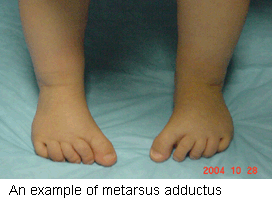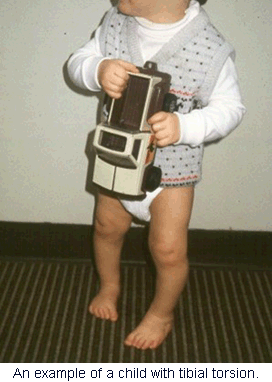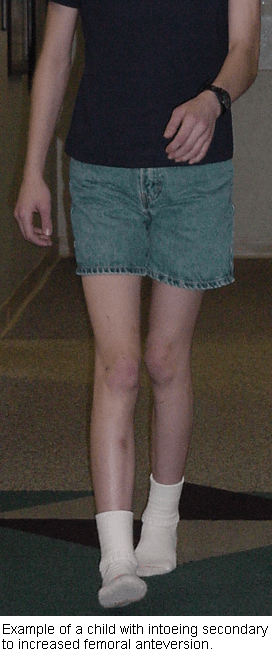Intoeing
Description
Intoeing means that the feet turn inward instead of pointing straight ahead when walking or running. This is commonly found in children at different ages and for different reasons. It almost always corrects without treatment as children grow older. The three most commonly seen conditions include metatarsus adductus (curved foot), tibia torsion (twisted shin-bone) and increased femoral anteversion (twisted thigh bone).
| Metatarsus adductus is a common finding in which your child's feet bend inward from the middle part out to the toes. Some cases may be mild and flexible, but others may be more apparent or rigid. In severe cases, it may be said to resemble a part of a clubfoot deformity.
|
 |
| Tibial torsion is a twisting of your child's lower leg (tibia). Before birth the legs were in a confined position and shaped to fit the womb. Internal tibial torsion means that after birth they didn't rotate outward. The feet turn inward because the leg bone above them points them that way. As the tibia grows taller, it is expected to grow out of the twisting.
Femoral torsion is in-turning of your child's thigh (femur bone). It is often most apparent when he or she is about 5 or 6 years old. The upper end of the thighbone has an extra amount of twist that allows the hip joint to turn inward more than it turns outward. This causes the knees to point inward when walking and the feet to toe in. Children with this condition often sit on the floor in the "W" position with their knees bent and their feet flared out behind them.
|
 |
Risk Factors/Prevention
All of these conditions may tend to run in families, or they can just occur on their own. Infrequently they may be associated with other orthopaedic problems. Prevention is not usually possible because they occur from developmental or genetic reasons that can't be controlled.
Symptoms
Severe intoeing may appear to cause young children to stumble or trip, particularly if they are wearing long or floppy shoes. Intoeing usually does not cause pain or interfere with the way your child learns to walk. Intoeing has not been linked to wear-and-tear arthritis in adulthood. Sometimes children who are faster sprinters tend to intoe a bit. It may be so noticeable that well meaning family or even strangers may comment about it.
Treatment Options
Parents or other family members often worry about a child's intoeing. They may believe the child or infant with intoeing will have permanent deformities as an adult. They may ask a doctor to "fix" the shape of their child's feet or legs. In the great majority of children under age 8, intoeing will correct without casts, braces, surgery or any special treatment.
Metatarsus Adductus improves by itself most of the time. It is usually appropriate to watch for improvement over the first 4 to 6 months of life. Applying casts or special shoes may be used to treat a foot with severe deformity or one that is very rigid. This has a high rate of success in babies aged 6 to 9 months. Surgical correction is seldom required.
Tibial Torsion improves almost always without treatment, and usually before school age. Splints, special shoes and exercise programs don't help. Surgery to re-set the bone may be done in a child who is at least 8 to10 years old and has a severe twist that causes significant walking problems.
| Increased Femoral Anteversion is expected to spontaneously correct in almost all children as they grow older. Studies have found that special shoes, braces and exercises don't help. Surgery is usually not considered unless there is a severe deformity in a child older than 9 or 10 years who has a lot of tripping and an unsightly gait.
|
 |
A child whose intoeing is associated with pain, swelling or a limp should be evaluated by an orthopaedist.
Research on the Horizon/What's New?
More advanced imaging techniques, such as CT scans have made it possible to more accurately measure the amount of abnormal twisting in the tibia and the femur for an older child with persistent and severe intoeing.
June 2004
All Information Copyright © American Academy of Orthopaedic Surgeons
www.aaos.org